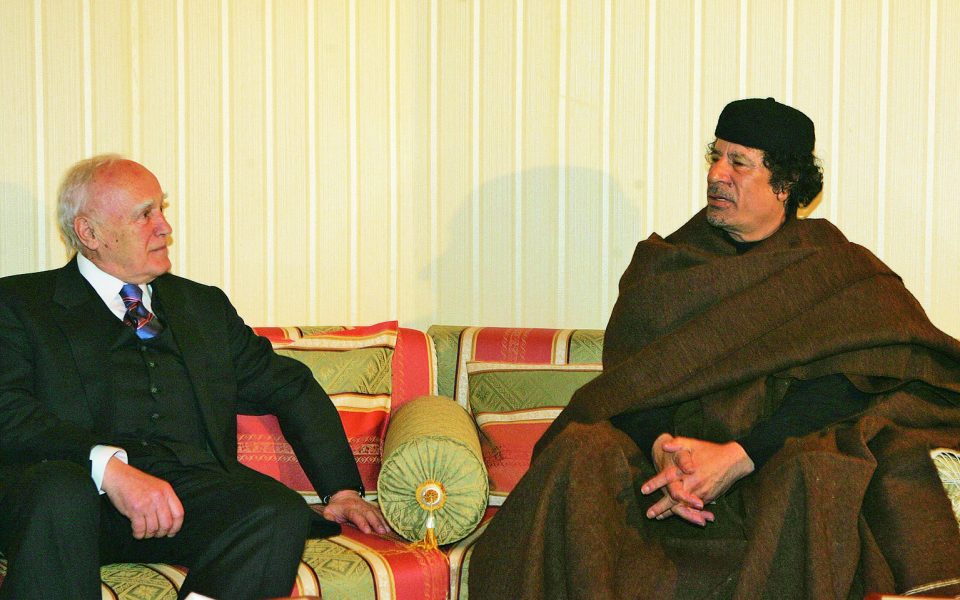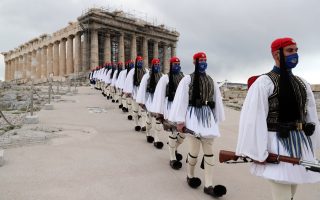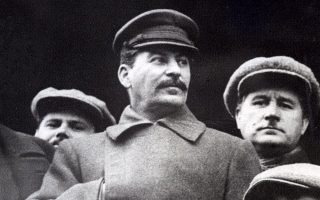Memories from Gaddafi’s ‘tent’

Kyriakos Mitsotakis was the first Greek prime minister to visit Libya. He had been preceded more than 15 years earlier by then-president Karolos Papoulias. Papoulias and Mitsotakis may have visited a country we all know as Libya, but in fact they visited two entirely different states.
In 2006, Papoulias visited a state called the Great Socialist People’s Libyan Arab Jamahiriya, heard “Allahu Akbar” (“God Is Great”) being played as the state’s national anthem upon arrival, “talked,” sort of, with the notorious Colonel Muammar Gaddafi, who led a terror regime with an iron fist, in a country rich in oil, in the latter’s “tent” (actually a wooden structure).
Mitsotakis was welcomed to “the State of Libya,” ruined by civil war and de facto still controlled by warrior tribal leaders, gangs and mercenaries and with the central government in Tripoli struggling to find its footing with the assistance of the international community. And, of course, Mitsotakis stood at attention to hear the hosts’ national anthem “Libya, Libya, Libya.”
Papoulias’ 2006 visit was mostly a PR event, with some hopes that Gaddafi, who then distributed oil wells to foreigners to help his regime survive, would grant us some small plot of land to drill, a request that fell through.
Now, a part of the wider geopolitical game being played in the Mediterranean revolves around Libya. So Mitsotakis’ visit was anything but frivolous.
Papoulias’ trip may not have been registered in the annals of Greek foreign policy as a fruitful exercise, but his meeting with the eccentric dictator remains unforgettable to all of us who accompanied the Greek delegation. I consigned part of that experience back then to Kathimerini’s pages. I quote that text, slightly enriched:
As the plane that transported President Karolos Papoulias, ministers, businessmen and journalists flew over the Mediterranean on March 13, 2006, most passengers’ thoughts were occupied with the upcoming meeting in Gaddafi’s famous tent. Our fertile imaginations had placed it deep in the Sahara Desert, perhaps at an oasis, where Gaddafi, dressed in Bedouin garb, would welcome the Greek president under the scorching sun.
For us journalists, at least, the reason we were making this trip was to witness that meeting of the two heads of state, who had known each other for years.
The climax of the trip would be 1300 hours, on March 13, when, according to the official schedule ‘Mr President’s departure for Muammar Gaddafi’s residence for the reception of the delegation in a special tent’ would take place. But the appointed hour came and went and President Papoulias and the other delegation members remained stuck at the luxury Corinthia Hotel.
Every now and then, we were summoned to prepare for departure, only to be told a little later that it wouldn’t happen. Was this some sort of hazing to which the eccentric dictator was subjecting his distinguished guest?
Our diplomats in Libya were telling us that the same thing had happened to Spain’s Jose Maria Aznar, the UK’s Tony Blair, Germany’s Gerhard Schroeder, French President Jacques Chirac and Italy’s Silvio Berlusconi, who had also rushed, but, in their case, in a timely fashion, to ask for a slice of the Libyan desert’s oil pie. Even though he had long stopped being the West’s preferred bogeyman, Muammar Gaddafi continued to hide and take incredible protection measures. The fear of being assassinated permeated him and, for good reason, for there had been actual attempts at his annihilation, especially on April 13, 1986, when the US sent F-16s from bases in Spain and the UK to bombard one of his homes in Tripoli in retaliation at Libya forbidding international shipping from entering the Gulf of Sidra.
Gaddafi avoided death, just, but many of his guards and one of his two daughters were killed. Since then, he had always been on the move and had stopped trusting anybody.
About 8 p.m., with the official schedule in tatters and our nerves shot, we were informed, at our hotel, that Gaddafi was waiting for the delegation in his tent and that we should depart immediately. The great moment had arrived! All of us were impatient to meet the man who was for some a legend and for others a picturesque dictator.
After an exhausting nighttime perambulation through the streets of Tripoli, the delegation arrived at a huge military barracks called Bab al-Azizia, in the southern suburbs, where Gaddafi had erected his famous tent – or at least one of them.
Soldiers in camouflage uniforms, armed to the teeth with Kalashnikov rifles – the famous female bodyguards appeared later, at the height of the reception, with pistols and in dress uniforms – were guarding the gate, with others placed at strategic spots; the barracks was encircled by thick barbed wire.
We had to walk seven blocks before we arrived at the tent where the meeting would take place. The guards confiscated our cellphones, so that US satellites could not pinpoint Gaddafi’s location.
To our intense disappointment, there was no tent, no desert and no camels. The fabulous “tent” was actually a huge, domed wooden structure, the epitome of bad architectural taste. In the structure’s anteroom, Gaddafi, wearing an Armani djellaba.
The talks lasted an hour. Us journalists waited outside a small, wooden door for statements.
Suddenly, the door opened. Two policemen in civilian attire jumped out and a hand poked out. I instinctively grasped the hand and my handshake with Gaddafi thus became reality.
I was startled, and actually scared, when I looked at him, shrouded in a purple djellaba, and his expressionless eyes. Instead of the “rugged colonel,” I was staring at a waxen figure that looked right out of Madame Tussauds. Inside, in the tent’s main room, he followed the Bedouin folklore show put on to honor and entertain his guests, silent and with a glassy stare. He was sitting with Papoulias on a platform sheathed in fine tulle and with sinuous female bodies swaying on the stage below them. The whole scene looked less like an official reception and more like a wedding reception in some Arabic neighborhood.
The following day, in Tripoli’s archaeological museum, among spectacular ancient Greek and Roman displays, in a prominent position, was his Volkswagen Beetle from the days when he led his revolution in 1969.
My next image of Gaddafi was that of his lifeless body being dragged through a street somewhere in Libya by gang members on a pickup truck.





